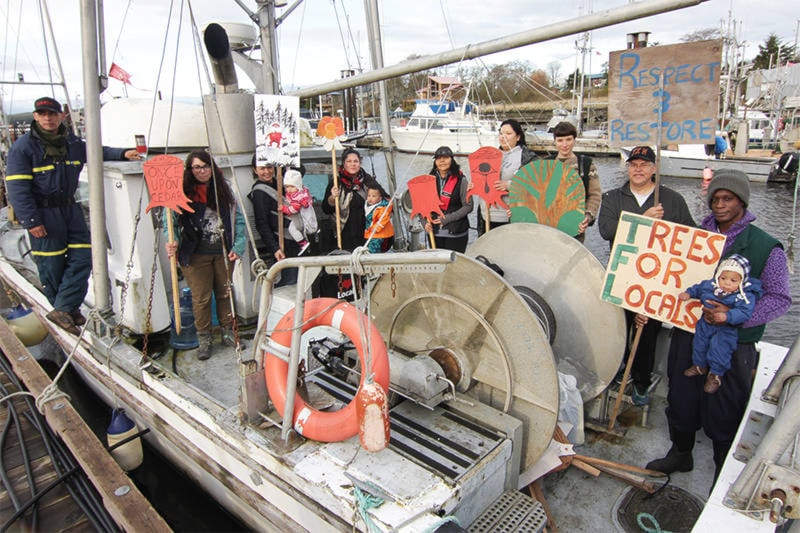Months after a court ruling against their blockade at Collison Point / St’alaa Kun, the Haida Gwaii Land Protectors still want industrial logging to stop.
“That’s our ultimate goal, to have our land restored back to what it used to be,” said Kildagwayaa, a member of the Land Protectors and the St’lang ‘Laanaas clan whose traditional territory includes Collison Point.
“That can’t happen while the land is still being assaulted.”
In April, the B.C. Supreme Court found that Husby Forest Products’ work at Collison Point is legal, and granted an injunction stopping the Land Protectors’ seven-week blockade.
The judge found the Council of the Haida Nation, which spoke as an intervenor in the injunction hearing, raised legitimate concerns about possible overharvesting of cedar at Collison, but said there are other ways to challenge Husby on that point.
“What is entirely unacceptable is the defendants’ use of arbitrary self-help remedies that undermine the rule of law and the administration of justice,” said Hon. Justice Jasvinder Bill Basran on April 26.
“No matter how valid their concerns, a blockade involving the use of weapons that prevents Husby from conducting its lawful operations is completely unacceptable.”
Husby crews returned to work at Collison Point on May 8. After months of monitoring the local ecology and forestry practices, the Council of the Haida Nation filed its own injunction over Collison Point on May 28, alleging that Husby has exceeded its annual cut, overharvested cedar from the area, and failed to properly identify dozens of monumental cedars.
Speaking in Old Massett, where they say there is near-unanimous support for an end to logging at Collison, Sherri Dick and Lisa White pointed out that the Land Protectors had no lawyer for the injunction that stopped the blockade. It was too costly, they said, and difficult since Husby chose not to name any particular people in the injunction — it was simply addressed to John and Jane Doe.
“Not naming us as who we are took away our identity as Haida people,” Dick said.
The Land Protectors dispute Husby’s claim that workers were intimidated by protestors who had a rifle and hunting knife, saying it was only for deer hunting and they had no idea Husby workers would be on site that day. A follow-up by local RCMP and CHN staff did not lead to any charges.
While they have particular concerns about Husby’s work at Collison — including the state of Kyaawan-Hancock Creek, the high number of monumental cedar felled in two cutblocks, where Husby’s logs are scaled — White and Dick said the issue is not Husby, but all industrial logging on Haida Gwaii.
“We’re taking this one battle at a time, and are hoping to set a precedent,” said Kildagwayaa.
Since 2010, the standard for forestry practices on Haida Gwaii has been set by the Haida Gwaii land-use order, which aims for ecosystem-based management and protection of Haida cultural values.
Kildagwayaa said she and her clan matriarch objected to the plan early on, and were dismissed.
Dick said she saw land-use planning as, “Come in and give yourself the right to scoop up everything as fast as you can and then deal with it later.”
“They got our leaders to sign agreements that aren’t beneficial to our people,” she said.
White said unlike traditional Haida forestry practice, she does not believe the current plan is sustainable.
“When they went in and single-selected trees, the rest of nature was able to survive there. It didn’t ruin anything, and for thousands of years it worked,” she said.
“What’s their long-term plan? Once they take away all those valuable trees, what’s their plan?”
White said the Land Protectors are now reviewing their legal options on the blockade injunction. She also called for an independent audit of the ecological and cultural resources in the area, perhaps by a university without industry or government ties.
As for the bigger picture, White noted that Canada has agreed to protect 17 per cent of its land by 2020, and suggested Haida Gwaii be protected as one of several UNESCO biospheres in Canada, such as the Tsá Tué Biosphere Reserve around Great Bear Lake.
“Why can’t we be on that list? Haida Gwaii has given enough.”
The Land Protectors also suggested putting the $45-million Athlii Gwaii Trust towards forest restoration work and rejected the idea, floated recently, that it be used to buy out Husby’s forestry tenure.
“Those funds should be used for restoration. They shouldn’t be used to buy our own land, our own trees,” said White.
Kildagwayaa said the goal is to have something for her children to inherit, and to eventually re-occupy the lands, building Haida longhouses again, as well as cabins for fishing, hunting, food and medicine gathering.
“Our culture will live on for eons if we keep this practice up,” she said.
